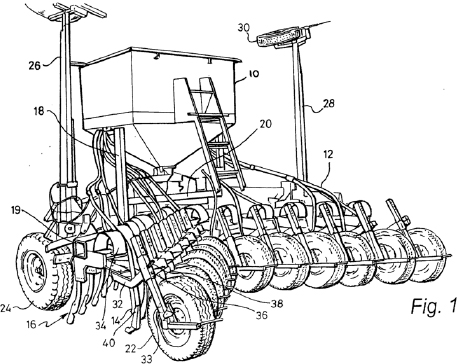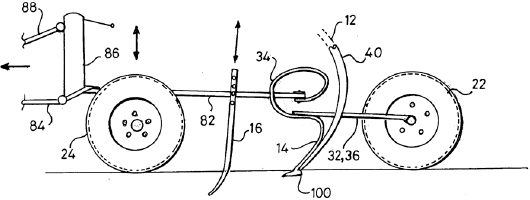Claydon Yield-O-Meter Ltd v Mzuri Ltd
| Jurisdiction | England & Wales |
| Judge | Hacon |
| Judgment Date | 22 April 2021 |
| Neutral Citation | [2021] EWHC 1007 (IPEC) |
| Court | Intellectual Property Enterprise Court |
| Docket Number | Case No: IP-2018-000045 |
| Date | 22 April 2021 |
[2021] EWHC 1007 (IPEC)
IN THE HIGH COURT OF JUSTICE
BUSINESS AND PROPERTY COURTS OF ENGLAND AND WALES
INTELLECTUAL PROPERTY ENTERPRISE COURT
Royal Courts of Justice, Rolls Building
Fetter Lane, London, EC4A 1NL
HIS HONOUR JUDGE Hacon
Case No: IP-2018-000045
and
Thomas St Quintin (instructed by Nash Matthews LLP) for the Claimant and Third Party
Brian Nicholson QC and David Ivison (instructed by Shakespeare Martineau LLP) for the Defendants
Hearing dates: 24–26 February 2021
Approved Judgment
HIS HONOUR JUDGE Hacon
Introduction
In 1701 Jethro Tull invented a seed drill, a mechanical device for sowing seeds with relative precision. It ultimately led to the end of broadcasting seeds by hand in agriculture, pushing forward the agricultural revolution of the time. This case is about modern descendants of Jethro Tull's seed drill.
The Claimant (“Claydon”) is a company based near Newmarket, Suffolk, which makes and sells agricultural machinery. The First Defendant (“Mzuri”) is a company based in Worcestershire which competes in the same market. Claydon alleges that Mzuri has infringed two of its patents.
The Second Defendant is the sole director of Mzuri. It is admitted that he is jointly liable for Mzuri's acts of infringement, if any.
The patents in suit (“the Patents”) are UK Patent No. 2 400 296 for an invention entitled “Improved seed drill” (“the 296 Patent”) and European Patent UK No. 2 051 576 (“the 576 Patent”) which claims another invention of the same title.
Mzuri counterclaims for revocation of the Patents. Mzuri is the sole counterclaimant and the principal defendant to Claydon's claim, so hereafter I will refer only to Mzuri.
Both Patents were granted to the Third Party (“Mr Claydon”) and thereafter assigned to Claydon. It is common ground that at the date of the claim form, although Claydon held the equitable ownership of the 296 Patent, the legal ownership remained with Mr Claydon. For that reason Mr Claydon was joined as the Third Party by way of being a defendant to Mzuri's counterclaim. Mr Claydon had a central role as a witness for Claydon but played no active part as Third Party.
The Witnesses
Mr Claydon gave evidence of fact on behalf of Claydon. He is the named inventor of both Patents. Mr Claydon was a good witness, giving clear answers. It was suggested in closing that he was obviously not impartial. Perfect impartiality would be a lot to expect from Mr Claydon but it does not follow that the answers he gave – principally directed to an alleged prior use – were inaccurate. Any material impartiality was not obvious.
Andrew Scarlett was Claydon's expert. Dr Scarlett is the director of Scarlett Research Limited, a company which provides research and technical services in the field of agricultural machinery and vehicles. Before starting this business Dr Scarlett spent 16 years at the Silsoe Research Institute where he managed research into and testing of tractor and field machinery. Dr Scarlett was clearly well informed about his field. On the whole, but not invariably, he gave clear answers.
Philip Wright was Mzuri's expert. He is a graduate of Silsoe College. After leaving Silsoe he joined Simba International Limited, a major UK manufacturer of agricultural machinery, rising to become the company's Technical Director, among other things being responsible for product design and development. Since 2007 Mr Wright has worked in his own consultancy business. Mr Wright gave knowledgeable answers to the questions put to him, again usually but not always clear.
There was evidence from Daniel Kelly who is the solicitor with conduct of these proceedings on behalf of the Defendants. His unchallenged evidence concerned a visit to Claydon's farm at Wickhambrook in Suffolk in support of the Defendants' case on prior use.
The Patents
The 296 Patent
The 296 Patent has a priority date of 29 March 2003. The specification begins by saying that the invention relates to a new method and apparatus for planting seed to produce agricultural crops. The section on the background to the invention explains that it concerns a seed drilling apparatus of the type pulled by a tractor. The invention may be used for sowing in minimally cultivated seed beds, creating conservation tillage in which the soil between the newly sown rows of the new crop is left relatively undisturbed. “Conservation tillage” is, as its name implies, a means of tilling soil in a manner better to conserve it, in particular by reducing soil erosion.
The specification indicates on page 7 why this feature is advantageous:
“The invention provides a seed drill and method which is different from anything currently available as it can direct drill or be used as a conventional drill over a wide set of soil conditions.”
The indication here is that the inventive concept is related to the disclosure of apparatus that can “direct drill” as well as be used as a conventional drill. As will be seen, “direct drilling” is a term of art but not a precise one. The specification continues on page 7:
“The drill is unique in the way it is set out, how it places the seed and in that it can deal with crop residues in an advantageous manner.
It also only cultivates the soil where the seed is to be planted, thereby creating a conservation tillage, by not disturbing the soil between the rows of crop. This has the advantage that weed seed in the soil between the sown rows will tend not to germinate because the soil between the rows has not been disturbed.”
The next passage on page 7–8 provides the reader with an idea of what the 296 Patent means by “direct drilling”:
“When used as a direct drill in straw or stubble it has the advantage of moving the crop residue such as straw and stubble onto the soil between the crop rows. This acts as a mulch, and further enhances weed control with the added advantage that the crop residue retains soil moisture.
This is a considerable advantage on lighter soils that can burn off in dry seasons. However the invention is equally applicable to heavier soils since the local break up and resulting aeration and drainage created by the first tines, below the seed depth, assists in the germination and subsequent growth of the seeds.”
“Direct drilling” as that term is used in the 296 Patent thus involves some degree of relocation of the soil in the crop rows, moving it on to the undisturbed rows.
Figure 1 is a diagram showing a machine embodying the invention:

As can be seen, the machine has parallel units, each of which has seeding tines (14) arranged in a V-shaped array, in front of which are slotter tines (16), which prepare the soil ahead of the seeding tines, arranged in a similar V-shaped array. Seed is fed from the hopper (10) to the seeding tines.
Figure 3 is a diagram of one of the units seen from the side:

At the centre of the unit is a frame member (82). The height of the frame from the ground is set by adjusting its heigh relative to the depth wheel (24). The height of the slotter tine (16) is adjustable. Behind the slotter tine is the seeding tine (14) with “A-hoe wings” (100) to direct placement of the seeds. Attached to the rear of the frame member is a levelling wheel (22). The levelling wheels firm the soil over the planted seeds, ensuring good contact between the seeds and soil and so promoting germination. Alternative levelling means may be used.
From the perspective of Figure 3 the machine moves from right to left. The tractor is thus to the left, linked to connections (84) and (88). As the slotter tines move forward though the soil, they break it to the desired depth. The seeding tines follow behind delivering the seed.
The introductory part of the 296 Patent states that the invention may leave undisturbed soil between the newly tilled rows and claim 1 of the 296 Patent has no such requirement. But Claydon alleged infringement of only claim 16 as dependent on claim 8. Claim 8 is a product claim which expressly requires the tines of the apparatus to be aligned in such a way that the soil will only be disturbed in spaced apart linear regions. This was a central feature of the invention relied on at trial.
This is claim 8:
“8. Apparatus for cultivating soil and sowing seed comprising:
(a) a frame, adapted in use to be towed by, or attached to the rear of, a tractor,
(b) a first row of tines carried by the frame and spaced apart across the width of the frame,
(c) a second row of tines also carried by the frame and spaced to the rear of the first row in the direction of forward motion of the apparatus when in use, and the second row tines are similarly spaced apart across the width of the frame so that each of the tines in the second row is aligned with one of the tines in the first row whereby in use soil will only be disturbed in spaced apart linear regions determined by the lateral spacing of the tines, and the strips of soil therebetween will not be disturbed,
(d) a hopper means containing seed,
(e) means for feeding seed therefrom down the rear and to the underside of each of the second tines,
(f) soil levelling means carried by the frame and located in alignment with the tines to the rear of the second row of tines (relative to the said forward direction of motion when in use), so that in use as the apparatus moves in a forward direction, soil that has been disturbed by the tines is generally flattened by the passage of the levelling means thereover.
This is claim...
To continue reading
Request your trial-
High Court Finds That Unobserved Trial Of Seed Drill Machinery In A Field Next To A Public Footpath Rendered The Patent Relating To The Invention Invalid For Prior Use
...step over the prior art. Therefore, there was no infringement. The claim was dismissed. (Claydon Yield-O-Meter Ltd v Mzuri Ltd [2021] EWHC 1007 (IPEC) (22 April 2021) ' to read the judgment in full, click The content of this article is intended to provide a general guide to the subject matt......
-
High Court Clarifies Appeal Procedures Following Remote Hand Downs of Judgments
...[1] Claydon Yield-O-Meter Ltd v Mzuri Ltd and Anor [2021] EWHC 1322 (IPEC). [2] See Claydon Yield-O-Meter v Mzuri Ltd & Anor [2021] EWHC 1007 (IPEC)). [3] Create Financial Management LLP v Lee [2020] EWHC 2046 (QB). [4] Those mischiefs being set out in Lisle-Mainwaring v Associated Newspape......

